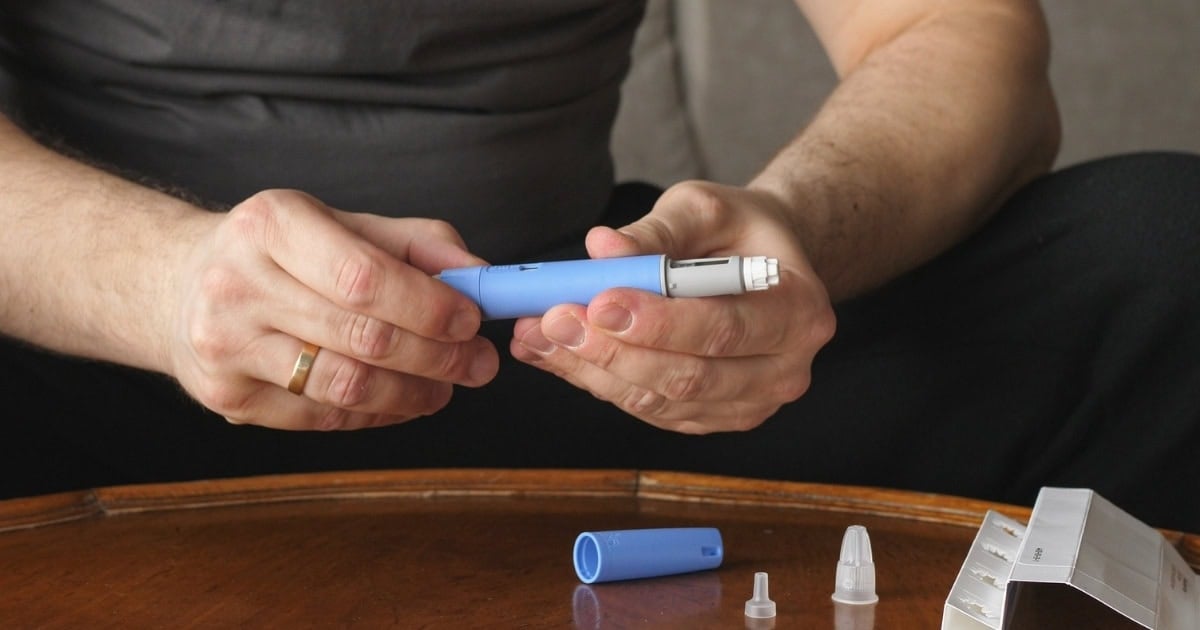Almost 50 percent of people starting Ozempic experience side effects. Most Ozempic side effects are mild and disappear over time or with adjustments to the dose.

Key Facts
- Common Ozempic side effects include nausea, vomiting, diarrhea, abdominal pain, and constipation.
- Serious but less common side effects include thyroid tumors, pancreatitis, gastroparesis, gallbladder issues, and severe allergic reactions.
- Ozempic’s suitability and safety should be discussed with healthcare professionals, especially for people with a history of pancreatic, kidney, or thyroid issues.
- Ozempic and Wegovy are the same drug and have the same side effects.
Common Ozempic side effects
A 2022 clinical trial at the Mayo Clinic Health System studying Ozempic’s effectiveness as a weight loss drug found that almost half of all participants experienced adverse effects.
| Ozempic Side Effects | Percentage of Study Participants |
|---|---|
| Any side effect | 48.6% |
| Nausea and/or vomiting | 36.6% |
| Diarrhea | 8.6% |
| Fatigue | 6.3% |
| Constipation | 5.7 |
| Abdominal pain | 5.1% |
| Headache | 2.9% |
| Acid reflux | 2.3% |
Severity of common side effects
While most side effects are mild, 11.5% of study participants had severe enough adverse effects that they had to adjust their Ozempic dose or discontinue the medication.
| Side Effect Severity | Percentage of Study Participants |
|---|---|
| None | 51.4% |
| Mild | 37.1% |
| Moderate | 8.6% |
| Severe | 2.9% |
Mild meant that the person could continue taking Ozempic as normal.
Moderate meant that the person had to reduce their Ozempic dose.
Severe meant that the person had to stop taking Ozempic.
How long does it take for common side effects to stop?
Mild gastrointestinal side effects generally disappear within a few days or weeks as your body gets used to the medicine. If they last longer than this or are severe, speak with your healthcare provider.
If you stop taking the medicine, you may continue to feel side effects for a few weeks as it leaves your system.
“I had a lot of nausea and vomiting for the first three to four weeks, but that has since dissipated.“
Stevie Cook (read about Stevie’s experience with Ozempic)
How to reduce or alleviate common side effects
Most common side effects are gastrointestinal (stomach-related), so it is a good idea to avoid foods, medications, and actions that can upset your stomach.
- Avoid greasy, fried, and very sweet foods
- Eat bland foods, such as crackers, rice, and toast
- Eat foods containing water, such as soups and gelatin
- Eat more frequent, smaller meals
- Eat slowly
- Don’t lie down after eating
- Stay hydrated by drinking unsweetened cold drinks (such as water)
- Be careful with artificial sweeteners and sugar alcohols
- Take anti-nausea medication (only after talking to your doctor)
If your side effects are severe or persist after a few days, talk to your doctor about adjusting your dose.
Start at the lowest dose and increase gradually—there is no rush to get to the higher doses.
Do not increase the dose if you feel nausea, vomit, have diarrhea, constipation, excessive belching or heartburn caused by the Ozempic.
Let your body adjust to the lower dose. Sometimes it helps to take it only once every 10 – 14 days instead of weekly to even more gradually increase the dose.
Dr. Anne Peters, Director of the Clinical Diabetes Programs at Keck School of Medicine of USC
Read Dr. Anne Peter’s answers to common questions about Ozempic.
Note: Following the approval of a medication by the FDA, the agency continues to monitor its side effects. Should you experience any adverse effects from using Ozempic, you are encouraged to report them to the FDA through their MedWatch program.
Rare but serious Ozempic side effects
Ozempic can cause rare but serious side effects.
Thyroid cancer
Ozempic has an FDA warning for thyroid C-cell tumors (thyroid cancer).
The concern regarding thyroid tumors is based on the results of studies using Ozempic and similar medications in animal studies. In this research, some rats and mice developed thyroid tumors, some of which were cancerous. It’s not known if Ozempic has this effect in humans.
Regulatory authorities are monitoring the U.S. annual incidence of medullary thyroid carcinoma (MTC) to determine if people taking Ozempic are more likely to develop this cancer (results expected 2035 – 2037).
Tell your healthcare provider if you experience symptoms of thyroid cancer, such as:
- A lump or swelling in your neck
- Hoarseness
- Trouble swallowing
- Shortness of breath
Do not use Ozempic if you or anyone in your family have ever had MTC, or if you have an endocrine system condition called Multiple Endocrine Neoplasia syndrome type 2 (MEN 2).
Pancreatitis
Pancreatitis is a medical condition in which the pancreas becomes inflamed, causing intense pain and affecting the pancreas’s ability to secrete insulin.
In clinical studies, a few people did develop pancreatitis while taking Ozempic. However, In two separate large studies, people taking Ozempic didn’t develop pancreatitis more often than those taking a placebo.
The scientific consensus is, therefore, that there is no direct evidence that Ozempic can cause pancreatitis.
It is worth noting that people with type 2 diabetes have an almost threefold risk of pancreatitis, whether they take Ozempic or not.
Stop using Ozempic and call your healthcare provider right away if you have symptoms of pancreatitis, including:
- Vomiting
- Severe pain in the upper part of your belly that travels to your back
- Your belly is tender to the touch
- Rapid pulse
Gastroparesis
Gastroparesis (also called delayed gastric emptying and stomach paralysis) is a disorder that slows or stops the movement of food from the stomach to the small intestine, even though there is no blockage.
If food stays in the stomach too long, bacterial overgrowth can occur as the food ferments.
The American Diabetes Association also notes that food can harden into solid masses called bezoars, leading to nausea, vomiting, and potentially dangerous and even life-threatening obstructions in the stomach.
Because one of Ozempic’s primary (and intentional) effects is to slow the speed at which food leaves the stomach and enters the intestines, it’s suspected that this can, in some cases, lead to gastroparesis.
One study led by researchers at University Hospitals in Cleveland found that people who were prescribed a GLP-1 medication for weight loss – such as semaglutide (branded as Ozempic and Wegovy), exenatide (Byetta), and liraglutide (Victoza) were significantly more likely to be diagnosed with gastroparesis at least six months later.
Stop using Ozempic and call your healthcare provider right away if you have symptoms of gastroparesis, including:
- Nausea or vomiting after eating
- Feeling full after eating only a small amount
- Severe bloating after meals
- Pain in the upper stomach (epigastric pain)
- Gradual, unexplained weight loss
- Loss of appetite
- Stomach wall spasms and cramping
Kidney damage
Only one of the original SUSTAIN trials reported an instance of acute kidney failure.
In a more recent FLOW clinical trial involving adults with type 2 diabetes and chronic kidney disease, Ozempic actually lowered the risk of kidney disease-related events by 24%.
In this trial, people taking Ozempic were less likely to experience at least one of the following:
- Loss of 50% or more of their kidney function
- Kidney failure
- Dialysis
- Kidney transplant
- Death from kidney disease
- Death from cardiovascular disease
Therefore, it’s safe to assume that Ozempic does not increase the risk of kidney damage. In fact, it may be a potential part of the cure.
Temporary vision changes
According to the American Academy of Opthalmology, temporary vision changes, such as blurry vision, are expected when starting Ozempic.
When blood sugar levels change, it can affect the shape of the eye’s lens, which causes blurry vision.
Because one of Ozempic’s main benefits for people with type 2 diabetes is lowering blood sugars, you may experience blurry vision until your blood sugars stabilize at a new level.
The older you are, the more likely you are to experience blurred vision when beginning the medication. The eye’s lens becomes less flexible as we age, so vision takes longer to stabilize when blood sugar levels change.
Diabetic retinopathy
Studies examining the relationship between Ozempic (semaglutide) and diabetic retinopathy have been inconclusive.
One study found an increased risk of retinopathy complications in patients, which is why Ozempic labels now include warnings about the risk of vision changes.
However, later studies found no association between semaglutide and retinopathy, and some studies have even indicated that semaglutide could help prevent retinopathy.
The current consensus is that Ozempic is unlikely to cause or worsen retinopathy, and if it does, it’s probably linked to changes in blood glucose levels, not the drug itself.
Blinding eye disease
One new study suggests a connection between Ozempic and increased risk for a blinding eye disease called non-arteritic anterior ischemic optic neuropathy (NAION).
However, Dr. Joseph Rizzo, the senior study author, emphasizes that the study shows an association rather than proving causation and that further studies are needed.
The current recommendation from experts is that most people should not be concerned about this, but that people with existing vision problems should consult with their doctor before taking Ozempic.
Gallbladder issues
Some people taking Ozempic have developed gallbladder inflammation (cholecystitis) or gallstones. It’s currently unclear if this is related to the drug.
Tell your healthcare provider right away if you get symptoms of gallbladder issues, which may include:
- Pain in your upper stomach (abdomen)
- Fever
- Yellowing of the skin or eyes (jaundice)
- Clay-colored stools.
Allergic reactions
Some people (less than 1% of people in the clinical trial) had skin reactions where the drug was injected. They included pain, redness, and discomfort, which generally went away on their own or after icing or taking Ibuprofen.
In rare cases, Ozempic can cause a severe allergic reaction. Stop using Ozempic and get medical help right away if you have any symptoms of a serious allergic reaction, including:
- Swelling of your face, lips, tongue, or throat
- Problems breathing or swallowing
- Stomach pain, bloating, vomiting, or diarrhea
- Severe rash or itching
- Fainting or feeling dizzy
- Very rapid heartbeat.
Hypoglycemia (low blood sugar)
If you live with diabetes and use Ozempic along with insulin or other diabetes medications, it can increase the risk of hypoglycemia.
Symptoms of hypoglycemia vary from person to person, but common symptoms to watch for include:
- intense hunger
- chills or sweating
- shakiness
- confusion or clumsiness
- blurry vision
- Slurred speech
You should always have foods that can quickly raise your blood sugar available in case you need to treat hypoglycemia. Good options are juice, glucose tabs, or sugar candy like jellybeans.
It’s also a great idea to have nasal glucagon (Baqsimi) available to treat extremely severe hypoglycemia where glucose tabs won’t work quickly enough.
If you have severe hypoglycemia and are afraid you will pass out, call 911 or your local emergency number.
Mental health issues and suicidal thoughts
There have been reports of people having suicidal thoughts after taking GLP-1 receptor agonists (the drug class that includes Ozempic, Wegovy, Mounjaro, etc.), and The Food and Drug Administration (FDA) said in 2023 that they were “evaluating the need for regulatory action.”
However, a 2024 study funded by the National Institutes of Health (NIH) found no link between semaglutide and suicidal thoughts.
In fact, the study found that “semaglutide is associated with a 49% to 73% lower risk of first-time or recurring suicidal ideations compared to other medications for controlling obesity and type 2 diabetes”.
There was some concern about an increase in suicide risk, but I don’t think that has proven true.
Dr. Anne Peters
Weight loss is both a goal and a side effect
In clinical trials for Ozempic, participants lost an average of about 15 percent of their body weight.
This is an intended effect, but it may not be good for you if you don’t need to lose weight.
It’s also important to be aware that not all weight lost from taking Ozempic will be fat. Studies disagree on how much muscle mass (and even bone density) may be lost as well, but at least some muscle loss is certain to take place.
Including resistance training in your treatment and exercise plan is highly recommended to avoid muscle loss.
Getting “Ozempic Face” after rapid weight loss
Rapid and significant weight loss, whether from medicine or other factors, can lead to changes in physical appearance.
One of these is changes in facial contours, or what is colloquially known as “Ozempic face.”
- A hollowed look and wrinkles in the face
- Sunken eyes and sagging jowls around the jaw and neck.
- Changes in the size of the lips, cheeks, and chin
The same thing can happen to other parts of your body when you lose weight rapidly.
Even though this is called “Ozempic face,” it’s not caused by the Ozempic but by the rapid weight loss.
If you experience concerning changes in your physical appearance while taking Ozempic, it’s important to consult with your medical team. They may recommend lowering your Ozempic dose and slowing down the pace of weight loss.
Ozempic, pregnancy, and birth control
The safety of Ozempic when pregnant or breastfeeding has not been thoroughly studied, but Animal studies suggest that there may be some risk to the fetus if Ozempic is used during pregnancy. Ozempic may also be present in breast milk.
It’s therefore recommended that you stop using Ozempic at least 2 months before becoming pregnant and don’t start it again until you stop breastfeeding.
Because Ozempic affects how quickly food and medication are absorbed in your stomach (and because vomiting is a common side effect), it may impact the effectiveness of birth control pills.
There is no published research or studies on semaglutide and birth control, but there are anecdotal stories of people getting pregnant while using birth control pills and taking Ozempic.
You may consider talking to your doctor about using other forms of birth control while taking Ozempic.
When to call your doctor or go to the hospital
You should immediately seek medical attention if you have:
- Severe vomiting and diarrhea
- Severe pain or tenderness in your belly
- Inability to pass gas or move your bowels
- Jaundice (yellow skin color)
- Allergic reactions at the injection site
In general, it is a good idea to tell your doctor that you are taking Ozempic or another GLP-1 drug. These drugs are new, and knowledge of risks and side effects is still improving.
Your doctor will be better able to diagnose any health problems and advise you on other medications and treatment options if they know you are taking Ozempic.
Frequently asked questions
Does Ozempic cause long-term side effects?
There are no known long-term side effects of Ozempic besides the ones listed above, but the drug has not been widely available for more than a few years, so the long-term safety profile is not fully known.
Can Ozempic cause hair loss?
Hair loss was not reported as a side effect in any of the clinical trials for Ozempic or Wegovy.
However, rapid weight loss can sometimes lead to hair loss, and patients with diabetes and high blood sugar are at higher risk of hair loss in general.
How does Ozempic affect the heart?
A 2023 clinical trial showed that semaglutide can reduce the risk of major heart and blood vessel events, including heart attack, stroke, or cardiovascular death, by up to 20 percent.
Ozempic has no known harmful effects on the heart or blood vessels and may become a common medication for lowering the risk of heart attack and treating heart disease in the future.
Did you find this article helpful? Click Yes or No below to let us know!






Addy Fritzhand
Very informative!